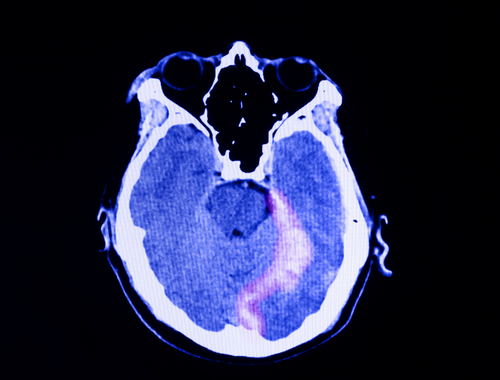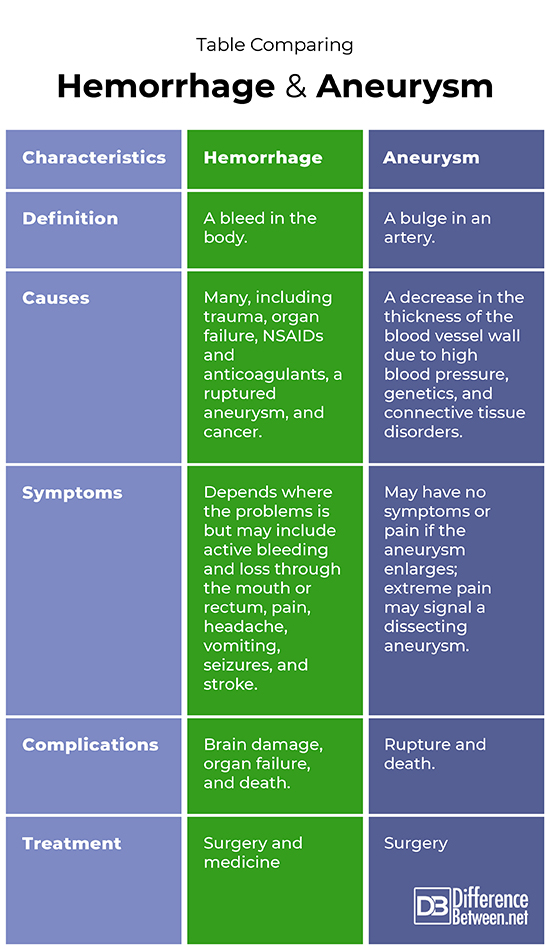Difference Between Hemorrhage and Aneurysm
A hemorrhage is when bleeding happens somewhere in the body. An aneurysm is a swollen area (a bulge) that develops in an artery.

What is Hemorrhage?
Definition:
A hemorrhage is when there is a bleed somewhere in the body.
Causes:
There are many causes of hemorrhage including traumatic injury, stomach gastritis or ulcer, cancer, liver failure, or a bursting aneurysm.
Symptoms and complications:
Symptoms depend partly on where the hemorrhage is, if in the brain, it can lead to a stroke and symptoms such as a sudden bad headache, nausea and vomiting, seizures, and difficulty communicating. Bleeds from the stomach or due to liver failure can have symptoms such as massive bleeding out of the rectum or mouth, and low blood pressure as a result. Certain drugs like non-steroidal anti-inflammatories can cause bleeding and so can anticoagulants. Complications of hemorrhage include brain damage, hypotension, organ failure, and death.
Diagnosis:
The diagnosis can be based on the presence of blood including blood passed in the stools and in vomit. Brain hemorrhages can be diagnosed by imaging tests including MRI and CT scans.
Treatment:
The treatment depends on where the hemorrhage is. Stomach bleeding may resolve on its own. If esophageal varices are bleeding due to liver failure, elastic bands may be used to tie off the bleeding veins. In the case of a brain hemorrhage, surgery may be needed to remove the blood and reduce pressure on the brain. Medications can help treat the symptoms of brain hemorrhage.

What is Aneurysm?
Definition:
An aneurysm is when a blood vessel starts to develop a bulging area. The most dangerous of these are when they occur in the aorta or in the brain.
Causes:
Brain aneurysms and aortic aneurysms can be due to high blood pressure, smoking, genetic factors, and some connective tissue disorders like Ehlers-Danlos syndrome and Marfan syndrome.
Symptoms and complications:
An aneurysm may not have any symptoms until it bursts. A person with a brain aneurysm may develop a headache that gets worse if the aneurysm starts to bleed. Severe symptoms occur if it bursts. An aortic aneurysm may also not give any signs of its presence. However, if an aortic aneurysm starts to dissect, an extremely severe tearing pain will be felt. Complications of brain aneurysms include stroke and brain damage. Aortic aneurysms can cause low blood pressure, tachycardia, and death if they rupture.
Diagnosis:
Imaging methods and angiography are the only way to detect an aneurysm. In angiography a special dye is injected into the bloodstream and then images are taken of the brain. An aortic aneurysm can be detected using ultrasound, an MRI, and CT scan.
Treatment:
Aneurysms do not always need to be treated. It depends on the location and size of the swollen area. Brain aneurysms can be repaired during brain surgery. Sometimes a stent can be placed to divert blood away from the aneurysm. Aortic aneurysms are measured to determine if surgery is needed. Generally, surgery is done on an aneurysm that is 5.5 cm or larger in diameter.
Difference between Hemorrhage and Aneurysm?
Definition
A hemorrhage is bleeding. An aneurysm is a bulge in an artery.
Causes
Hemorrhages have multiple causes including trauma, liver failure, use of NSAIDs, and burst aneurysms. Aneurysms are often caused by hypertension or are due to inherited conditions.
Symptoms
Depending where it occurs, a hemorrhage can have symptoms such as blood loss from the rectum or mouth, headache, and hypotension. An aneurysm may have no symptoms unless it is dissecting, which causes pain.
Complications
Brain damage, organ failure, and death are complications of a hemorrhage. Rupture and death are complications of an aneurysm.
Treatment
Medicine and surgery may be needed to control hemorrhaging. An aneurysm sometimes requires surgery.
Table comparing Hemorrhage and Aneurysm

Summary of Hemorrhage Vs. Aneurysm
- A hemorrhage is when there is bleeding in the body.
- An aneurysm is a bulge that develops in an artery.
- A hemorrhage and aneurysm often need to be treated.
FAQ
Is a brain hemorrhage an aneurysm?
No, a brain hemorrhage is when there is bleeding in the brain while an aneurysm is a swollen blood vessel.
Is a brain hemorrhage worse than aneurysm?
Yes, a brain hemorrhage is more dangerous, especially if it is from a burst aneurysm because it can very rapidly place pressure on the brain leading to damage and death. A small aneurysm may not be as harmful and may not even have symptoms unless it grows or bursts.
What are the 3 types of aneurysms?
The three types of aneurysms based on location are cerebral, thoracic aortic, and abdominal aortic. The three types of brain aneurysms based on shape are saccular, fusiform, and berry.
What’s the difference between an aneurysm and a stroke ?
An aneurysm is a swollen area (bulge) in an artery in the brain. A stroke is when blood flow is restricted to some part of the brain either due to a brain bleed or a clot lodging in an artery in the brain.
What is the main cause of aneurysm?
The main reason for aneurysms forming is a thinning of the blood vessel wall. High blood pressure can aggravate this condition increasing the risk of an aneurysm bursting.
Can an aneurysm go away?
It is very unlikely that an aneurysm will just go away. Usually, surgical repair is needed if an aneurysm grows larger or causes problems.
What is life expectancy after aneurysm?
A person can live normally with an aneurysm provided it does not grow larger or rupture. Even after repair of an aortic aneurysm the survival after 10 years is only about 60%.
Can stress give you an aneurysm?
Stress can potentially weaken blood vessels and lead to an aneurysm because stress raises your blood pressure. Blood pressure is the force of blood pushing against the walls of a vessel as it passes through them. The higher the pressure is the more damage that can be done on the walls of an artery.
Are there warning signs of an aneurysm?
For brain aneurysms the person may have vision changes or headaches. There may also be a loss of feeling on one side of the face.
- Difference Between Rumination and Regurgitation - June 13, 2024
- Difference Between Pyelectasis and Hydronephrosis - June 4, 2024
- Difference Between Cellulitis and Erysipelas - June 1, 2024
Search DifferenceBetween.net :
Leave a Response
References :
[0]Chong, Ji Y. “Brain Aneurysms (Cerebral Aneurysms and Intracranial Aneurysms” . Merckmanuals. Merck & Co., 2022, https://www.msdmanuals.com/professional/neurologic-disorders/stroke/brain-aneurysms
[1]Mayo Clinic. “Subarachnoid hemorrhage”. Merckmanuals. Merck & Co., 2022, https://www.mayoclinic.org/diseases-conditions/subarachnoid-hemorrhage/symptoms-causes/syc-20361009
[2]Müller-Forell, W., and J. Bohl. "Psychic stress as a trigger of the spontaneous development and rupture of an aneurysm? A case report." Interventional Neuroradiology 5.2 (1999): 179-186.
